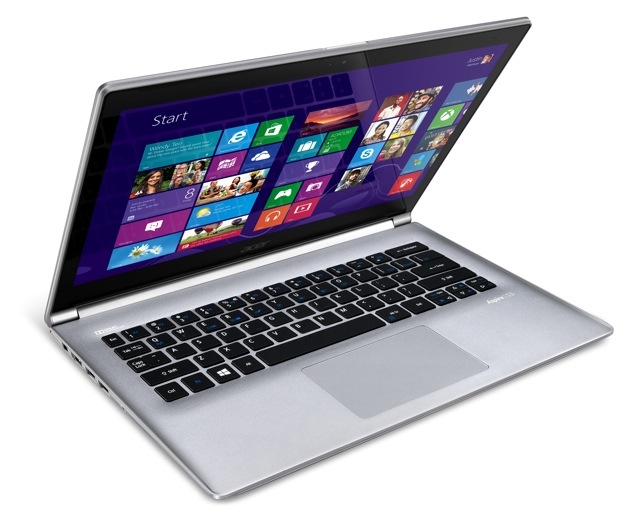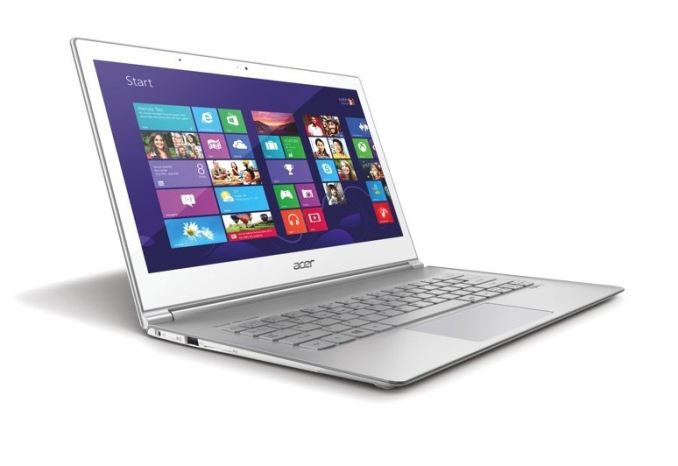Acer Announces 8" Iconia W3 Tablet, S3 and S7 Haswell Ultrabooks
by Vivek Gowri on June 3, 2013 7:25 AM ESTComputex is always a big stage for mobile device launches, and Taiwanese manufacturers always seem to bring a little bit extra to their home technology expo. Acer’s press event at Computex 2013 took place earlier today, where they announced some interesting new Windows 8-based devices.
The most notable has to be the Iconia W3 tablet, the first sub-10” device we’ve seen running the latest variant of Windows. We’ve known of the W3’s imminent arrival for some time now, but its no less significant of a launch because of it. It’s a Clover Trail-based Atom slate with Windows 8, an 8.1” 1280x800 display, and a bundled copy of Office Home and Student 2013. Internally, the W3 runs on Intel’s 1.5GHz Atom Z2760 SoC, which we’re very familiar with at this point after dealing with it inside a number of different Windows 8 tablets in the last six months, along with 2GB of DDR3. It’s also got a 2MP rear-facing camera (at that resolution, why even bother?), a single USB port, and 8 hours of battery life. It’ll hit store shelves later this month priced at $379 for a 32GB model, which also makes it the least expensive Windows 8 tablet we’ve seen thus far and undercuts the street pricing of the 64GB ASUS VivoTab Smart by about $50, plus the added cost of Office. The 64GB W3 comes in at $429. A Bluetooth keyboard accessory will also be available.
The W3 is an interesting return to the days of UMPCs, when pocket-sized Windows devices seemed like a legitimate possibility. Back then, the devices were thick, slow, and had terrible battery life, but with the advent of low-power x86 chips, the hardware concerns have been fixed. The W3 comes in at a light 1.1lbs, though the 0.45" thickness is a bit more than we're used to seeing in modern tablets of this size (it's about 60% thicker than the iPad mini). Obviously, the Bay Trail version is the one to wait for, and we already have concerns about the display - it’s not an IPS panel, and reports have pegged it as “needing work” - but the W3 represents a step forward for Windows tablets.
Acer has also updated their flagship Aspire S7 ultrabook with Haswell processors, a WQHD touchscreen display, and improved battery life. It’s had a mild industrial design freshening, with a new unibody aluminum chassis (still a Gorilla Glass lid), along with revised cooling design and a newly refined keyboard with an updated layout and deeper keystrokes. It’s still a remarkably thin computer, at just over a half-inch thick and 2.86lbs. Haswell and WQHD touchscreens are going to be template for ultrabooks going forward, and we’ve already seen ASUS announce the Zenbook Infinity with similar specs. The 10-point capacitive multitouch 2560x1440 IPS display is undoubtedly going to be a very high quality panel, though the Windows experience will be a question. It wasn’t particularly good on Toshiba’s KIRAbook, and I’m skeptical of how Windows responds to UI scaling at high DPIs in desktop mode. The 11” model has been dropped, and the S7 will ship in July at similar price points to the original S7 (MSRP, not current street pricing).

There’s also a new Aspire S3 Haswell-based ultrabook, basically a lower end version of the S7 with similar design language, a completely aluminum chassis (no glass on the lid), and a slightly thicker and heavier chassis - though at 0.7” thick, it’s still pretty slim. The 3.67lb weight is pretty high for the ultrabook class of notebooks, but that can likely be attributed to the optional GeForce GT 735M dedicated graphics. This will not be the only instance in which we’ll see an OEM go with Haswell plus a low-end dGPU for ultrabooks instead of a Crystalwell Haswell GT3e part. The S3 comes with a 1080p IPS display panel and hybrid storage, offering a large storage drive and a solid state cache in place of the purely SSD storage of the S7. Price points are appreciably lower at around the $1000 mark, with the S3 also shipping in July alongside the S7.
We’ll have more to say about the new Acer systems in the coming days, along with much more coverage of Computex 2013.











16 Comments
View All Comments
ET - Monday, June 3, 2013 - link
According to The Verge the W3 weighs 1.1 pounds. I think it's a worthwhile data point to include.Also hands on reports on various sites say that the screen is crap. I hope they change it to IPS for release. With even tablets under $150 coming with 1280x800 IPS screens, I can't understand using anything lesser.
Braumin - Monday, June 3, 2013 - link
Also for Snap to work, it needs to be at least 1366 wide... seems like Acer forgot this. Maybe Windows 8 Blue will change that requirement though since it offers a different (and better) snap anyway.arnavvdesai - Monday, June 3, 2013 - link
Actually with Windows 8.1 that requirement has been dropped to 1280x768 and Snap works with variable %age scaling i.e. not just 1/3 or 50% like before.guidryp - Monday, June 3, 2013 - link
While I would never accept anything less than IPS (or equiv) on a tablet, I suspect they are cutting corners because they have to. The Intel processor likely cost a bit more than an ARM and the Windows license certainly cost MUCH more than Android.Klimax - Tuesday, June 4, 2013 - link
There was report few months back, that OEM license got significant price drop. (Something about 100USD or so) Don't remember if it was ever confirmed.gxtoast - Monday, June 3, 2013 - link
What's the continuing obsession with over-res'd 13" screens? Seriously, 15" factors outsell 13" factors and these guys aren't bringing out thin and light fifteens.Even FHD on a 15" screen is enough to exude quality. Over-res'd screens draw more power and consume higher iGPU cycles. Does this really sell them more product?
Homeles - Monday, June 3, 2013 - link
It's better than the under-res'd screens that we've had to put up with forever.maximumGPU - Monday, June 3, 2013 - link
let's just agree then that for 13" 1080p is the sweet spot!Winterblade - Monday, June 3, 2013 - link
The way Windows manages the high DPI panels I have to say that even 1080 at 13" is an overkill. I'm constantly zooming to be able to read web pages without forcing my eyes, also without a dedicated GPU is not going to be possible to play games at native resolution AND to have a decent framerate... In short, it's not that I'm against these new high DPI panels, It's just that I feel that once again OEM's are just selling us specs even if that means to breake the "balanace" of their systems.BMNify - Monday, June 3, 2013 - link
Yup, that's the crux of the issue with Win32 and the solution is compromise. IPS and proper tuning (color, contrast, etc.) at a modest resolution can result in a quality display that aids the Win32 deficiency while increasing battery life and decreasing BOM.Unfortunately, the marketing ass clowns want bullet points (cuz that's all consumers know), engineers want results, and bean counters want beans. Clearly the engineers are being overruled and we get cheap TN or impractical super duper hi-hi-def IPS (that still need tuning). I personally thought that MS got it pretty close to right with the Surface RT screen except that, well no one wants RT.